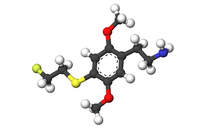2C-T-21

| |

| |
| Names | |
|---|---|
| Preferred IUPAC name
2-{4-[(2-Fluoroethyl)sulfanyl]-2,5-dimethoxyphenyl}ethan-1-amine | |
| Other names
4-(2-Fluoroethylthio)-2,5-dimethoxyphenethylamine
| |
| Identifiers | |
3D model (
JSmol ) |
|
| ChEMBL | |
| ChemSpider | |
PubChem CID
|
|
| UNII | |
CompTox Dashboard (EPA)
|
|
| |
| |
| Properties | |
| C12H18FNO2S | |
| Molar mass | 259.34 g·mol−1 |
Except where otherwise noted, data are given for materials in their standard state (at 25 °C [77 °F], 100 kPa).
| |
2C-T-21 (4-(2-fluoroethylthio)-2,5-dimethoxyphenethylamine) is a psychedelic phenethylamine of the 2C family sometimes used as an entheogen. It was first synthesized by Alexander Shulgin.
Dosage
In his book PiHKAL (Phenethylamines i Have Known And Loved), Shulgin lists the dosage range as 8–12 mg.[1]
Effects
2C-T-21 is generally taken orally and effects typically last 7 to 10 hours.[1] The potential psychotherapeutic applications of this chemical were explored by Myron Stolaroff.[citation needed]
Pharmacology
The mechanism that produces 2C-T-21's hallucinogenic and entheogenic effects has not been established; however, it may result from action as a 5-HT2A serotonin receptor agonist in the brain, a mechanism of action shared by all of the hallucinogenic tryptamines and phenethylamines for which the mechanism of action is known.
Dangers
On March 9, 2004, a 22-year-old
This death became part of a two-year DEA investigation called
Legality
2C-T-21 is unscheduled and uncontrolled in the United States, but possession and sales of 2C-T-21 would probably be prosecuted under the
Canada
As of October 31, 2016, 2C-T-21 is a controlled substance (Schedule III) in Canada.[3]
References
- ^ a b Alexander Shulgin. "2C-T-21". PiHKAL.
- ^ "News from DEA, News Releases, 07/22/04". Archived from the original on February 8, 2008.
- ^ Regulations Amending the Food and Drug Regulations (Part J — 2C-phenethylamines)
